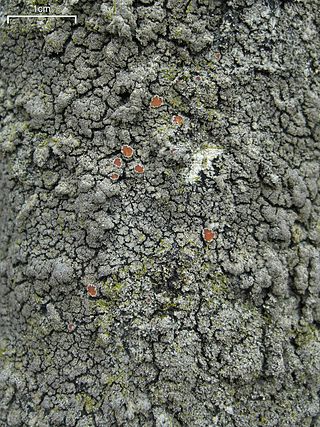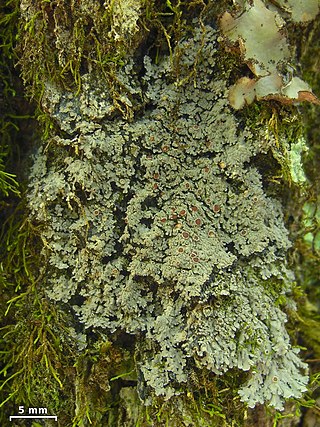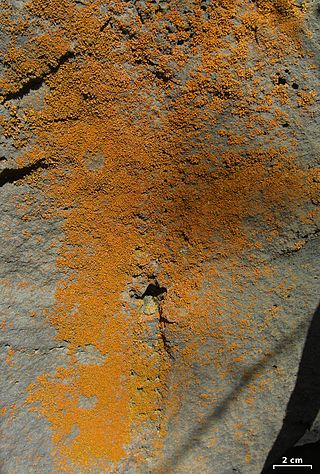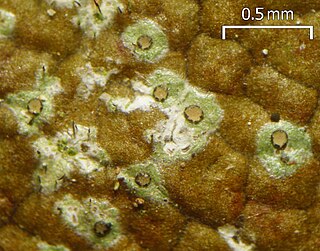
Erioderma pedicellatum is a medium-sized, foliose lichen in the family Pannariaceae, commonly called the boreal felt lichen. It grows on trees in damp boreal forests along the Atlantic coast in Canada, as well as in southcentral Alaska and in the Kamchatka Peninsula.

The Pannariaceae are a family of lichens in the order Peltigerales. Species from this family have a widespread distribution, but are especially prevalent in southern temperate regions.
Biatorellaceae is a family of lichen-forming fungi in the subclass Lecanoromycetidae. The family is monotypic, and contains the single genus Biatorella, which contains eight species.

Sarcographa is a genus of lichen-forming fungi in the family Graphidaceae. It is estimated to contain 37 species. The genus was circumscribed by French botanist Antoine Laurent Apollinaire Fée in 1825.

Parmeliella is a genus of lichenized fungi in the family Pannariaceae. It occurs mainly in the tropics and sub-tropics, with species found in Africa, Asia, Australasia and South America. A recent (2020) estimate places 41 species in the genus.

Pannaria is a genus of lichen-forming fungi in the family Pannariaceae. The widespread genus contains an estimated 51 species, found primarily in tropical regions.

Fuscopannaria is a genus of lichen-forming fungi in the family Pannariaceae. It has 55 species.

Degelia is a genus of lichen-forming fungi in the family Pannariaceae. The genus is named after Swedish lichenologist Gunnar Degelius.

Xanthomendoza is a genus of small, bright orange foliose lichens with lecanorine apothecia. It is in the family Teloschistaceae. Members of the genus are commonly called sunburst lichens or orange lichens because of their bright orange color.

Enterographa is a genus of lichens in the family Roccellaceae.

Anisomeridium is a genus of lichens in the family Monoblastiaceae. The type species was originally named Arthopyrenia xylogena by Swiss botanist Johannes Müller Argoviensis in 1883; in 1928, Maurice Choisy defined the genus Anisomeridium, designating A. xylogena the type species.

Dermatocarpon is a genus of lichens in the family Verrucariaceae.

Tricharia is a genus of lichens in the family Gomphillaceae. It has an estimated 30 species.

Leptogium is a genus of lichen-forming fungi in the family Collemataceae. It has about 110 species. Species formerly classified under Leptogium have since been divided among the genera Leptogium, Pseudoleptogium, and Scytinium. Leptogium lichens are predominantly found on tree bark or soil, often among mosses, and sometimes on rocks in moist environments.

Chrysothrix is a genus of lichen-forming fungi in the family Chrysothricaceae. They are commonly called gold dust lichens or sulfur dust lichens, because they are bright yellow to greenish-yellow, sometimes flecked with orange, and composed entirely of powdery soredia. Apothecia are never present in North American specimens.

Peltigera canina, commonly known as the dog lichen, is a widely distributed species of foliose lichen in the family Peltigeraceae. It was originally described by Carl Linnaeus in his 1753 work Species Plantarum. German botanist Carl Ludwig Willdenow transferred it to the genus Peltigera in 1787. This species is currently undergoing research as it is likely multiple species under one united name.

Scytinium is a genus of lichen-forming fungi in the family Collemataceae. It has 49 species. These lichens are typically found on basic rocks, soil, and trees, occasionally in association with mosses. Despite the morphological and ecological diversity within Scytinium, its species share similar ascospore features, such as shape and septation, as well as a small to medium-sized thallus with at least a partial cortex.
Apatoplaca is a fungal genus in the family Teloschistaceae. It is monotypic, containing a single species, the rare crustose lichen Apatoplaca oblongula, found in the United States.

Megalospora is a genus of lichen-forming fungi in the family Megalosporaceae.

Fuscopannaria leucosticta, commonly known as the rimmed shingle lichen, is a species of lichen in the family Pannariaceae. It has a squamulose (scaley) thallus that lacks soredia and isidia, but has abundant apothecia with distinct white rims. Although its main centres of distribution are eastern North America and southeast Asia, where it grows in damp forests, it has been reported from various other high-altitude, humid locations.

















